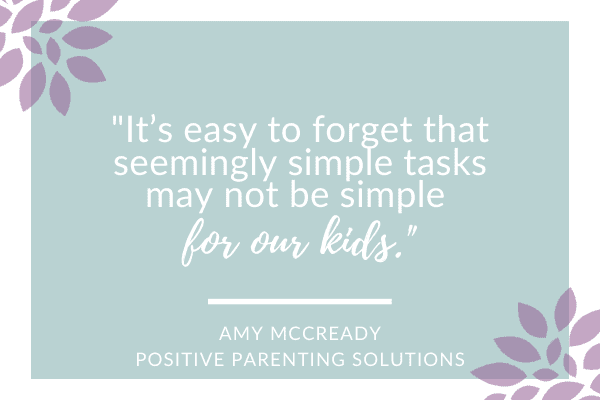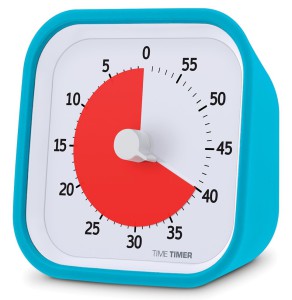6 Tips for a Smooth Bedtime Routine

After a long day of “adulting,” your on-demand shows are calling your name. All that stands between you and your couch is a little bedtime prep with your kids. What could go wrong?
“All right, it’s time for bed,” you say, with a little too much gratefulness and enthusiasm.
“No, not yet! I’m not tired!”
“Just a little longer, pleeeeease?”
“I hate bedtime!”
You knew courteous, immediate compliance was a little hopeful–but you weren’t expecting war-time resistance.
After all, your toddler is yawning and tripping over toys, your 6-year-old is giggling maniacally, and your teenager is blinking heavily at her video game.
You can’t fathom why the prospect of bed is so outrageous. They’re clearly as exhausted as you.
For many families, bedtime is tough. It’s prime time for power struggles, chaos, and stress.
Getting to the bottom of power struggles is important (which is one reason why I created my free introductory positive parenting class), but the fact that everyone is so tired at the end of the day makes bedtime battles particularly difficult.
Basically, it’s akin to 2 AM at the local nightclub when–unless people start heading home–all hell will break loose. Nothing gets better at a nightclub after 2 AM. And for kids at home? Try 7 PM.
Luckily, there’s an easy solution. A good set of strategies to help avoid common bedtime power struggles can really make a difference. It may seem simple, but I promise–implementing these 6 basic tactics can help earn you and your family the rest you deserve.
1. Same Time, Same Order, Same Place
I get it–a routine can be super inconvenient in these crazy-busy lives of ours. We have school activities that run late, projects to tackle, and family movie nights that interfere with bedtime.
And that’s okay. For the occasional exception, like a Billie Eilish concert keeping our kids up late, some flexibility is necessary.
But although a routine can feel like a downer when everyone’s enjoying their evening, in reality…it can be a lifesaver. For those of us who haven’t already implemented a routine, it is the first step in combating bedtime battles.
Start by setting a reasonable bedtime that is the same every night, including on the weekends. Thanks to the circadian rhythm, a reliable schedule actually helps the body know when to fall asleep.
A consistent schedule has the added benefit of limiting a child’s pleas for a later bedtime. After all, the less we bend and budge, the less room they have to negotiate.
Next, we can make activities leading up to bedtime orderly and consistent. A warm, soothing bath at the same time every day followed by books in bed is common for younger kids. For teenagers, it could be 9:00 PM when they start brushing their teeth, washing their faces, and lying in bed listening to music before lights out at 9:30 PM.
Certain repeated actions can trigger a body’s sleep response making it easier to get kiddos to cooperate. Just make sure that the actions follow good sleep hygiene, like doing something quiet and subdued.
When-Then Routine
When establishing a new routine, especially one less lenient, kids might rebel. They’ll test our boundaries to see if we’re really serious and try to delay the inevitable.
This is a great time to use a When-Then Routine.
This tool helps motivate kids to complete the more mundane parts of their bedtime routine they may dislike. For example, we can say:
“Connor, when you’ve flossed your teeth, then I can read you a bedtime story before lights are out at 8.”
Or: “Evie, when you’ve taken a shower, then you can read your book until lights out at 9.”
Our kids are ultimately in control of when they complete these tasks, which helps dispel a battle of wills. They’re also more likely to complete the tasks relatively quickly because they want to get to the things they enjoy; like getting tucked into bed or reading the latest vampire romance novel.
The then has nothing to do with a prize or a reward. It’s just something kids regularly enjoy more than other things like flossing. And that’s not hard to find.
Just like a consistent bedtime, When-Then becomes doubly powerful when it’s used routinely. When kids know what to expect each night, they’re more likely to comply.
Note: If the child doesn’t complete the “when” part of the routine before bedtime, this doesn’t change the time the lights go out.
If they dilly-dally and don’t complete their tasks until 3 minutes before lights out, then you can simply say, “I’m sorry you didn’t get to read before bed tonight. I have faith you’ll be able to complete your routine tomorrow.”
To further back-up the cut-off for lights out, you can even utilize a tool like the Time Timer.
What we love about the Time Timer is it’s a VISUAL timer, not a simple countdown timer. Visual timers can help even the youngest kiddos conceptualize time in a more meaningful way than simply setting a timer on your phone or microwave.
And, once the clock starts, this reminds the kids that the routine–and time–are the boss.
2. Take Time for Training
A routine is a reliable solution, but for younger kids especially, we can’t expect a perfectly performed routine without a little practice.
It’s easy for parents and kids alike to become frustrated when kids struggle or procrastinate with tasks–especially when we ourselves are getting ready for bed.
It’s also easy to forget that seemingly simple tasks may not be simple for our kids.
A two-year-old isn’t going to know how to put on her inside-out pajamas until we show her, step-by-step. If we overlook this, her whining and crying might translate into our own unhelpful aggravation and yelling.
A four-year-old isn’t going to correctly brush his teeth until we take the time to demonstrate round circles, soft strokes, spit… don’t forget the tongue! Otherwise, he might start crying when we ask him to “hurry up, please.” You get the picture.

If we take a little time upfront to teach our kids what we expect from them and what the new routine in our households will be, it will save us time and effort later.
Although it might be tempting, we shouldn’t give up and do things for our kids, either–even though it might be faster and easier.
With patience on both ends, our kids will eventually feel empowered by what they can do for themselves–and we’ll feel empowered, too.
Pro Tip: For access to Curing the Bedtime Blues, an additional guide for all Positive Parenting Solutions members, sign up for our Online Course today!
3. Anticipate Children’s Needs
Your eyes are settling on the final chapter of your page-turner when you hear that familiar little voice in the next room.
“Mooooooom? Daaaaaad?”
You cringe a little, set the book down, and reluctantly say, “Yes, honey?”
“I’m scared. I can’t sleep.”
“Can you bring me a glass of water?”
“I have to go to the bathroom.”
Lately, this has been happening every night and you’re fed up with the pattern.
Many kids have fears at bedtime. Some are afraid of the dark, others of monsters, and many have bad nightmares and night terrors. Often, kids go to bed before they’re tired or when they’re overtired, and some like to stay up as late as possible regardless.
We can start by considering whether or not the bedtime we’ve set for our kids is too early or too late. Although kids need as much as 8-14 hours of sleep (depending on a child’s age and genetics), a bedtime that isn’t quite right works against everyone.
You might need to experiment to find the sweet-spot time for lights out–one that is most likely to get your child snoozing the soonest.
Next, we can proactively add the items that our kids are commonly requesting into the next evening’s routine.
“Carson, here’s a glass of water on your nightstand, just in case you get thirsty again tonight. Now, will you help me look in your closet for monsters? I know there aren’t any in there, but I want you to see for yourself. And let’s turn on your new nightlight!”
If our children are still sending us on one bedtime quest after another, the thing they’re most likely after is our attention. Which brings us to this:
4. Splurge on Quality Time
Our children thrive on feeling significant and important. They want to matter–especially to us.
I always encourage parents to spend quality one-on-one time with each of their children individually. Ideally, this should be done every day for at least 10-15 minutes–doing something our kids want to do.
By providing this huge dose of positive attention proactively, you’ll drastically reduce the attention-seeking misbehaviors you see from your kids; like whining about bedtime or dragging it out with endless requests. In fact, this is the #1 thing I recommend to parents all the time for cutting back on misbehavior across the board!
Beyond that, there are so many anxieties that keep us all awake at night. A child’s anxiety may differ from ours, like an irrational fear of giant purple people-eaters, but some are also very real and just as terrifying, like the spread of the Coronavirus.
If we can give kids a good dose of tender love and care, it can work wonders for a child’s need for attention and a sense of security. An excellent opportunity to share that special time together is right before bed.
After all, happiness and fulfillment lead to better sleep.
And while there’s nothing wrong with a parent vs. kids pillow fight now and again, keep in mind that energizing activities are ideally followed by calm ones.
5. Practice Gratitude
Much like feeling loved and significant, kids that focus on things they’re happy about or thankful for before bed have an easier time falling asleep.
We can encourage a teenager to keep a journal on his nightstand and write down three good things that happen each day at school.
We can cuddle a 4-year-old and ask her what her roses and thorns were that day; the roses being her favorite experiences, the thorns her least favorite. Then, we can put extra emphasis on the roses.
Positive thoughts can improve anyone’s life. Even if it begins by getting a better night’s sleep, that small difference can make an impact the next day, and the next. With so many things in the world outside of our control, the way we perceive and manage our thoughts to our advantage–which is within our control–is crucial.
Just like with routine and tasks, regular gratitude takes some training. But if we teach our kids to focus on the haves instead of the have-nots, they might just fall asleep with smiles on their faces.
6. Limit Technology Usage
With the invention of the light bulb, a large quantity of the world population started staying up later than usual. Now it’s television, iPads, and iPhones keeping us up well into the night.
We’re so addicted to lights, screens, and technology that we even bring our phones into bed with us.
Screen time right before bed is extremely harmful in many ways. It alerts a part of the brain, making our minds assume it’s still daytime.
It means we’re tempted to watch scary movies or read the news right before bed (both of which can be equally disturbing). Children with screens in their rooms have access to all of this and more.
Despite establishing internet controls, just staying up late playing games or having an emotional conversation with a BFF can cause kids stress and sleeplessness.
Even for teens, many of which have a biological tendency to stay up later, allowing them screen-time two hours or less before bed can rob them of sleep.
Limiting technology is hard at first. It will cause arguments, which of course we want to avoid. But standing firm on this commitment will eventually eliminate bargaining and late-night screen time dangers.
Note: Positive Parenting Solutions Members, please refer to the Battle-Tested Blueprint: Technology Survival Plan to learn how to set appropriate limits around technology that the whole family can agree on–kids included!
Final Thoughts
If you’re still reading this, chances are that bedtime in your house hasn’t been a walk in the park.
Starting tonight, I encourage you to give these strategies a try and see what wonders they work on your nocturnal wannabes.
Most families nowadays need a lot less chaos and a lot more sleep. Enforcing a good bedtime routine will help avoid power struggles and bring a healthier balance to our lives.
I truly believe reliable rest and relaxation are in your future. And those under-eye circles you’ve been trying to hide? They’ll be gone before you know it.
So go on now, and get those kids to bed. Your favorite shows are waiting.
You’re not alone–bedtime battles are just one of the many power struggles that families face. My free online introductory class was designed to help parents understand WHY these common struggles and misbehaviors occur and learn what you can do to resolve them. Check it out!
What You Should Do Next:
1. Get Quick Actionable TIPS delivered to your inbox
Sign up for my newsletter for parenting tips to help you create a happier home and become the parent you always wanted to be. Plus, when you subscribe, I'll also send you a copy of our strategy-packed guide 10 Tips for Better Behavior – Starting NOW!
2. Unlock the secrets to easier parenting in my FREE CLASS
Register for my free class called How to Get Kids to Listen, Without Nagging, Yelling or Losing Control. Classes run several times per week to accommodate your busy schedule.
3. Transform your family with the 7-Step Parenting Success System® Course
Join the hundreds of thousands of parents who have transformed their families with the 7-Step Parenting Success System® Course. Learn the tools you need to raise happy, respectful, responsible kids and create the family life you always dreamed of having.
About the Author






